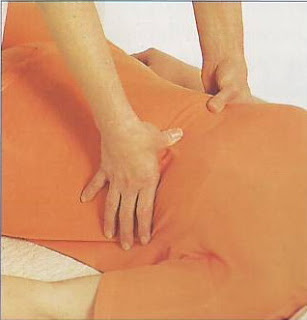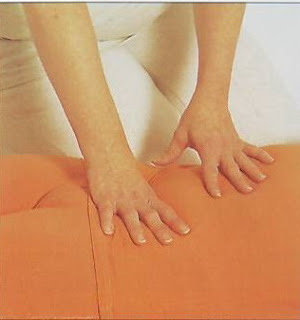The techniques demonstrated
in Lesson Four stimulate the energies of the internal organs. Deep and thorough
abdominal massage boosts the immune system. Always allow three hours after a
meal before working the abdomen.
Deciding on what degree of pressure is just right for a
particular individual can be difficult. People vary enormously in their ability
to tolerate pressure. In Western cultures people are unused to having their
abdomens deeply massage. That massage techniques for the abdomen are deeply
penetrating. Be attentive to your partner’s facial expressions and body
reactions, and always obtain verbal confirmation that the pressure exerted is
tolerable.
Sen channels on the abdomen
 |
ABOVE: these are the nine pressure points on the
abdomen, which must be thoroughly pressed if energy balance in the internal
organs is to be achieved.
|
There are nine pressure
areas or zones in the abdomen, with the navel in the center. Start in the lower
right section and always press around the abdomen in a clockwise direction.
There are two main
techniques. Firstly, thumb walks the lines on the diagram. Start at zone j and thumb walks all
around the edge to zone r. You
can then vary this pattern by going j - n - j - n - r - n - r and then j - r.
Secondly, double palm press zones j - n on the right side
and then move to the left side and press zones o - r.
1. PRESSING THE CHEST, SHOULDERS & ARMS
With your arms straight,
palm your partner’s upper pectoral region using a slow, rocking movement of
your body to generate pressure.
Take care not to press this area too hard. If your partner is
a man, you can palm the entire pectoral area. Now extend the palming down the
arms to the hands, keeping the pressure even through. Palm back up the arms and
repeat the palming of the pectorals.

- Techniques 1, 2 and 3 are
designed to tone the internal organs, particularly the lungs, and benefit
asthma/bronchitis sufferers.
- Palming the arms contributes to the overall energy balance within the body.
2. PRESSING THE CHEST
Maintaining your position,
use both hands as shown to palm press down the mid-line of your partner’s chest
on the breastbone. Press with a to-and-fro pushing movement to create a rocking
effect and, with a female partner, always restrict your pressing to these
areas.

- 1. PRESSING THE
CHEST, SHOULDERS & ARMS
Pressed: Pectorals, deltoids, biceps, wrist extensors
3. PRESSING BETWEEN THE RIPS
(INTERCOSTAL MUSCLES)
Touch Method One:
Thumb press the intercostals between your partner’s ribs simultaneously
outwards from the sternum. Start with both thumbs either side of the sternum
just below the collar bone and progress downwards. If you have a female
partner, be prepared to press some of the intercostals spaces in the center
only. Also, be sensitive to those for whom the rib spaces are major tickling
spots!
Touch Method Two: Now use your three middle
fingers of both hands to press across the ribs with a small circular motion.
Again, progress downwards, observing the same precautions as for the
intercostals pressing.
4. THUMB WALKING THE ABDOMEN
Kneeling on your partner’s
right, use the thumb walking technique and start just above her groin on the
right side in zone 1. Thumb walk slowly, rhythmically and deeply without
causing pain to the right side across the abdomen just below the rib line, and
down the left side to just above the pubic bone from zone 1 to zone 9.
Repeat this circuit several times and then thumb down the mid-line
a few times. You can vary this pattern by thumbing clockwise around the two
triangular areas shown on the image of Sen channels on the abdomen.

- Encourages the smooth flow
of energy through the abdominal Sen to relax the abdominal muscles.
5. PALM PRESSING THE ABDOMEN
Imagine your partner’s
abdomen divided into nine equal zones with the navel in the center. Begin in
zone 1. As she exhales, press with the heels of both hands aiming towards the
navel and gradually and carefully increase the pressure. Hold for up to two
minutes.
Ask her to take a deep breath as you release the pressure.
Repeat for zones 2 to 5. Move to her
left and continue on zones 6 to 9.

- Regular massage using
Exercises 5 and 6 aids digestion, relieves heartburn and constipation, also the
heaviness experienced in the lower abdomen during the premenstrual period.
6. PRESSING FEET TO STOMACH
Sit between your partner’s
legs, hold her hands and carefully place the balls of your feet side by side on
the upper abdomen. Press alternately with care to cover the whole abdomen.

- Regular massage using
Exercises 5 and 6 aids digestions, relieves heartburn and constipations, also
the heaviness experienced in the lower abdomen during the premenstrual period.

- 3. PRESSING
BETWEEN THE RIBS
Pressed: intercostals
- 4. THUMB WALKING THE ABDOMEN
Pressed: All abdominals
- 5. PALM PRESSING THE ABDOMEN
Pressed: All abdominals
- 6. PRESSING FEET TO STOMACH
Pressed: All abdominals













